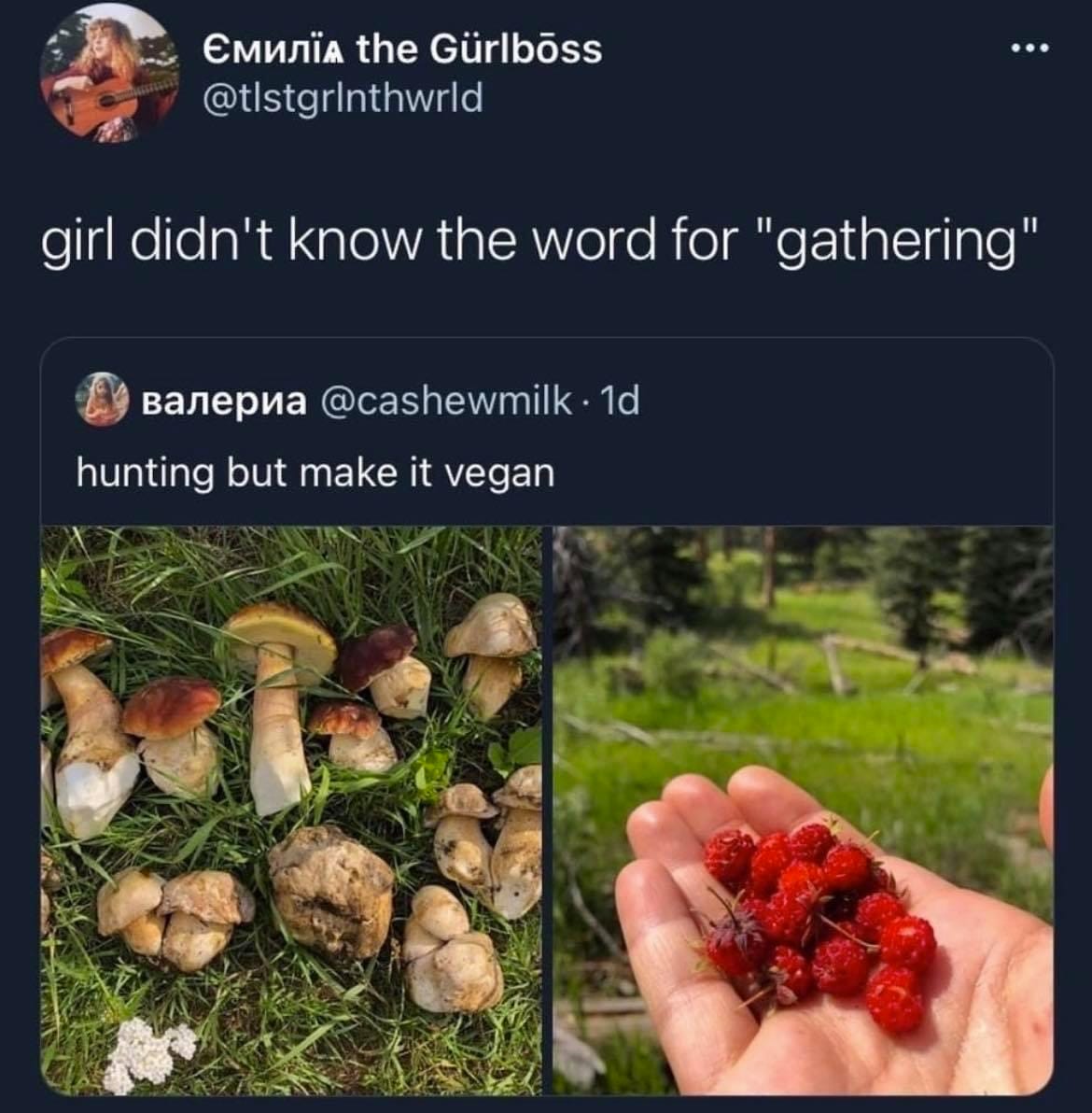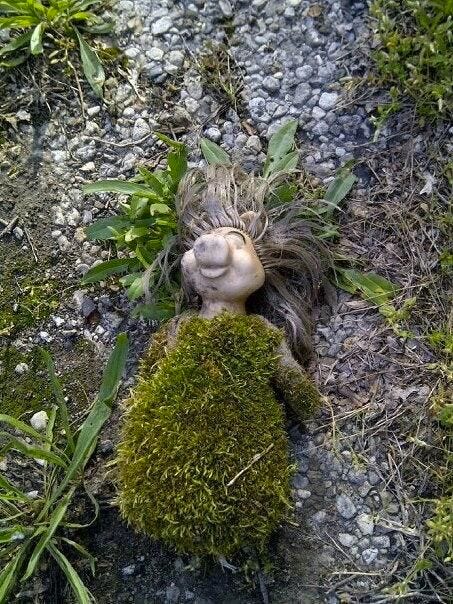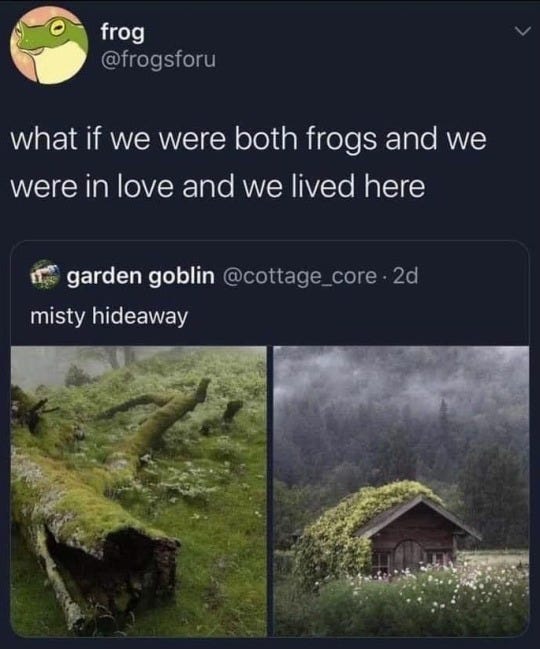Cottagecore: Don't mistake colonial fantasy for connection
Do you want actual land connection or to live inside a pretend colonial memory?
Kia ora koutou! It’s Tam here!
Today’s post is the topic everyone was fizzing about in the comments a fortnight ago when the Group Chat Collective first came on the scene. Our Canadian correspondent, Becka (you can read more about her here) has written about the tension that arises when you live on and tend to stolen land.

My earliest memories of understanding that there is a connection between us and the land that we’re on, are of picking blackberries on a dusty Coromandel driveway attached to a bach where we would catch frogs and also sometimes find mouse droppings in our rice bubbles. Every year the berries were there, abundant, ripe for crumbles and jams. Free and ready to be picked. But blackberry also keeps much of themselves back from us, so many berries inaccessible due to thorns and height leaving them available for the birds and insects, and bears depending on where you are, to also get their fill. Its prickliness ensuring that everyone’s needs are met.
I spent my teen years as a weirdo baby queer (although certainly did not know that yet myself) in rural Waikato and Hawkes Bay, feeling isolated amongst the Aertex shirt, gigantic mono-crop farm, Field Days of it all while also being strangely drawn to it. (I now have some more nuanced thoughts around queerness and rural/farm life than I did then, but that’s a post for another time perhaps.)
Now I live in downtown Vancouver with a garden on the roof of my apartment building, a plot at a community garden on land that in recent history was a speedway track but that had forever been a tidal flat wetland until it was stolen by colonisers who didn’t care to understand the landscape. And I work on an urban farm that was once the city dump, next to a ravine full of salmonberry and poplar trees. All of which are on stolen unceded, Musqueam, Squamish, and Tsleil-Waututh land.
All this to say, this is where the “Becka is in Canada living the cottagecore dream” comes from, and to give it some context. Because I can be annoyingly stubborn and bring a “you cannot define meeeeee!” vibe, I do chafe a little bit at the idea of cottagecore. However, am I writing this while looking at a bundle of dried borage hanging above a stack of books on folklore while listening to Irish traditional music? Sure. Did I bring home my seeds from work to organise “for fun”? Yes. But will I organise those seeds while bingeing Love is Blind? Also yes! I contain multitudes, life is a rich tapestry, etc.
With all of this on the table, the critiques and the desires, there are a couple of key things I try to constantly keep front of mind when I am in my garden or when I am daydreaming of a house in the country with beehives and some kind of dreamy creek situation.
Decolonise your mind, do you want actual land connection or to live inside a pretend colonial memory?
I chafe at the cottagecore aesthetic not only because I am obstinate, but in large part because of it being so glaringly white, and I would argue at times dangerously tradwife/fash adjacent. An aesthetic of thatched roofs, gathering apples in your apron, wandering through swaying hollyhocks, and reading poetry under willows is both beautiful and full of fairly easy threads to pull at for critique.
Who actually has access to this kind of lifestyle? Who has access to land? Who has access to the time and labour this requires? Should we be nervous of the implied narratives of purity and tradition, especially when so much of this particular aesthetic is borrowing from colonial cultures and an imagined past? Don’t farm women often look more like they could carry a pig under each arm than be willowy apple girls? I would say yes to that last question, yes definitely to the one before that (fascists famously love these values, hate to say that Hitler also wore a flower crown), and the answer to the first three is almost always wealthy able-bodied white people.
Does that mean that it is wrong to desire those things? Be it that list above or to just want the space in your life to have a little veggie patch, to learn to forage, to be more DIY, to have easier access to connecting with the land in whatever way that might look like where you are? Not at all! I also want these things, and I think it makes a lot of sense that many of us do as we struggle in a system of capitalism and colonialism that constantly seeks to alienate us from each other. Just as there are ways to engage with this aesthetic that we should be wary of, engaging with and learning these skills or ways of living can also be radical and revolutionary.
The goal of Indigenous sovereignty is always at the centre. Or: doing a land acknowledgement and just going about your day is not the one.
Scientist, author, and citizen of the Potawatomi Nation, Robin Wall Kimmerer says “Knowing that you love the earth changes you, activates you to defend and protect and celebrate. But when you feel that the earth loves you in return, that feeling transforms the relationship from a one-way street into a sacred bond.”
But what does that mean for us who are on stolen land? We can’t confuse the hope for this bond with an unfiltered or unchecked right to the land. And we can't disconnect the people of the land from our love and reciprocity. One of my favourite places in the city is a 1000 acre urban park, forested with gigantic cedar trees, surrounded by the ocean and containing a small marsh that I visit as often as I can. But, like many city and even provincial or national parks, Stanley Park was created by forcibly evicting and burning villages of the Squamish, Chinese, and Squamish-Portuguese living there. The legacy is truly horrific.
We often think about colonisation as something that happened in history at a fixed point, when really it is a continuing project not just of stealing land but upholding a colonial state and a colonial mindset. This is a tension for many of us who love the land; we really have to question what that means and how we express this in actuality. Māori land-based art and research collective, Kauae Raro, has some really useful prompts for this on the IG page, here.
For me that looks like letting go of the garden that I’m working in as being mine, and reminding myself that each patch of land is connected to and in conversation with the others. At the farm, we don’t use chemical pesticides and fertilisers, and when I ask visitors why they think that might be the response is often that organic food is healthier for us. Maybe so, but that is quite an inward-looking (and often privileged in ways I spoke of earlier) perspective.
I eat non-organic food *all the time*. Hello to the Flake wrapper sitting next to me as we speak, or my beloved cheap ramen noodles. Still, I also only use organic practices in my garden, because I know that chemical pesticides get into our waterways and kill off native plants and animals, directly impacting Indigenous ways of life.
Beyond the vegetable garden, I try to prioritize planting what grows here rather than living for an imported colonial aesthetic. Look, I love wisteria as much as the next Anne of Green Gables girlie and it is a great and beautiful plant! But there are many great and beautiful plants that belong to this land that I also love especially when I shift that mindset. I know that soil has been degraded so significantly worldwide due to construction, extraction, and pollution, that supporting soil health by using (usually Indigenous) permaculture1 practices has a ripple effect of supporting the health of the whole ecosystem that my garden or our farm sits within. Also it is often less work and I do love to be lazy.
With farming having been used to steal and degrade land, undoing or doing the opposite of these practices feels like one way I can work to support land back. Some of these things will result in changes I see in one season, and some will take many seasons for those changes to happen. But if I have made the shift from my garden being mine and for me, to one that is in the collective, what does it matter when they happen?
Community wellbeing, in! Culture of self-sufficiency, out.
Hooo boy, self-sufficiency sure is a big calling card of the beribboned cottagecore lifestyle. Grow your own, tend your own, don’t need to rely on anyone. Sounds empowering! But rugged individualism is also a calling card of colonialism and capitalism. Self-sufficiency is just preppers who like to garden. People working together is scary to power. Not needing to rely on shitty tin arse governments who don’t have our best interests at heart, yes! But replacing that with webs of community resilience allows us to embrace the truth that my liberation is inherently bound up with yours.
In her excellent book, As We Have Always Done, Leanne Betasamosake Simpson says, “My Ancestors didn’t accumulate capital, they accumulated networks of meaningful, deep, fluid, intimate collective and individual relationships of trust. In times of hardship, we did not rely to any great degree on accumulated capital or individualism but on the strength of our relationships with others. The Michi Saagiig oral tradition has within it stories of Wendat and Rotinonhsesh:ka /Haudenosaunee coming to us and asking to hunt or farm in our territory during times of famine. Our grounded normativity compelled us to assist our neighbors if we were able.”
We have likely all heard the annoying line that what people in poverty really should be doing is starting a garden. Let me refer you back to our earlier questions of who has access to land, time, capacity, money? But when one person is able to grow tomatoes to share or trade with their neighbour who grows potatoes, or with their other neighbour who fixes their plumbing, or passes them to a different neighbour who drops them off to the person down the road who works full time or has difficulty leaving the house? Now we’re talking.
My beloved blackberry: an introduced and invasive plant that perhaps did not choose to be on this land, but nonetheless is and often doesn’t have great manners. I will continue to harvest their fruit in late summer, the vines for weaving in spring, and dig them out to compost when the soil is soft in the rain. Hopeful that while the birds and bears are still fed, my making crumbles and jams for myself and my friends will both nourish us and reign in that ungovernable vine somewhat to make more room for the berries who have known this land and its people for time immemorial.
As is the way of white people, permaculture is often Indigenous technologies observed/stolen and repackaged as ideas plucked from thin air by white dudes. The ideas are of course still very good! But I recommend looking for a range of sources, and definitely checking out Farming While Black by Leah Penniman.







Loved this Becka - “The goal of Indigenous sovereignty is always at the centre. Or: doing a land acknowledgement and just going about your day is not the one.” 👏👏👏👏 yesss I think about this so much. How do you move on from the “I’m
Privileged and I know” statement that doesn’t actually hold depth and a commitment to use that privilege or disrupt that privilege or unpack that privilege? I think about that a lot. Thank you for this beautiful post.
I've been looking into my family's history, and a lot of my ancestors were brought over to NZ on reduced fairs, under contract to clear a certain amount of rainforest per year. I looked up the place where my father's paternal grandparents lived when they got married and it looks like it was freshly confiscated land. These two things are just the tip of the iceberg. I don't really know how one balances out the harm one's direct ancestors were present for and participating in. I do believe you can never sit through too many Treaty of Waitangi classes (and I have sat through many).